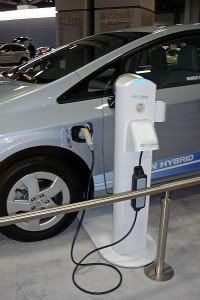Electric Vehicles on Techcrunch
Earlier today, a friend sent me a link to this discussion of electric vehicles on Techcrunch, one of the great blogsite successes of the past few years.
The article features the way-cool work of Plug-In America in its ongoing advocacy position for EVs. The discussion beneath, however, was rather alarming. Either the site is full of shills from the oil companies, or there actually are well-educated young people who believe that EVs offer little or no ecological advantage over internal combustion engines.
It seems they needed me – a guy old enough to be most of these commentors’ father – to point out:
A point worth mentioning here is that we could 90 million EVs on the road this afternoon, charge them with off-peak (overnight) power, and not put ANY additional load on the grid; most of that power is thrown away, as it’s too expensive to store. More on this at: http://2greenenergy.com/category/electric-vehicles/.






![[The Vector] Rice University Creates Green Carbon Center](http://2greenenergy.com/wp-content/uploads/2010/11/Green-energy-150x150.jpg) Rice University in Houston, Texas announced the creating of a clean energy think tank. It will study and strategize environmentally sound policies for current and for new energy sources. James Tour is heading up the collaboration. He is a Rice University professor in Chemistry who wrote a paper about Nature Materials which discusses rapid expansion of solar and wind energy and the long-term need for carbon-based energy. Carter Kittrell, a Rice research scientist, and Vicki Colvin, Rice’s Pitzer-Schlumberger Professor of Chemistry join the collaboration.
Rice University in Houston, Texas announced the creating of a clean energy think tank. It will study and strategize environmentally sound policies for current and for new energy sources. James Tour is heading up the collaboration. He is a Rice University professor in Chemistry who wrote a paper about Nature Materials which discusses rapid expansion of solar and wind energy and the long-term need for carbon-based energy. Carter Kittrell, a Rice research scientist, and Vicki Colvin, Rice’s Pitzer-Schlumberger Professor of Chemistry join the collaboration.




 We’re starting to hear more about
We’re starting to hear more about 


